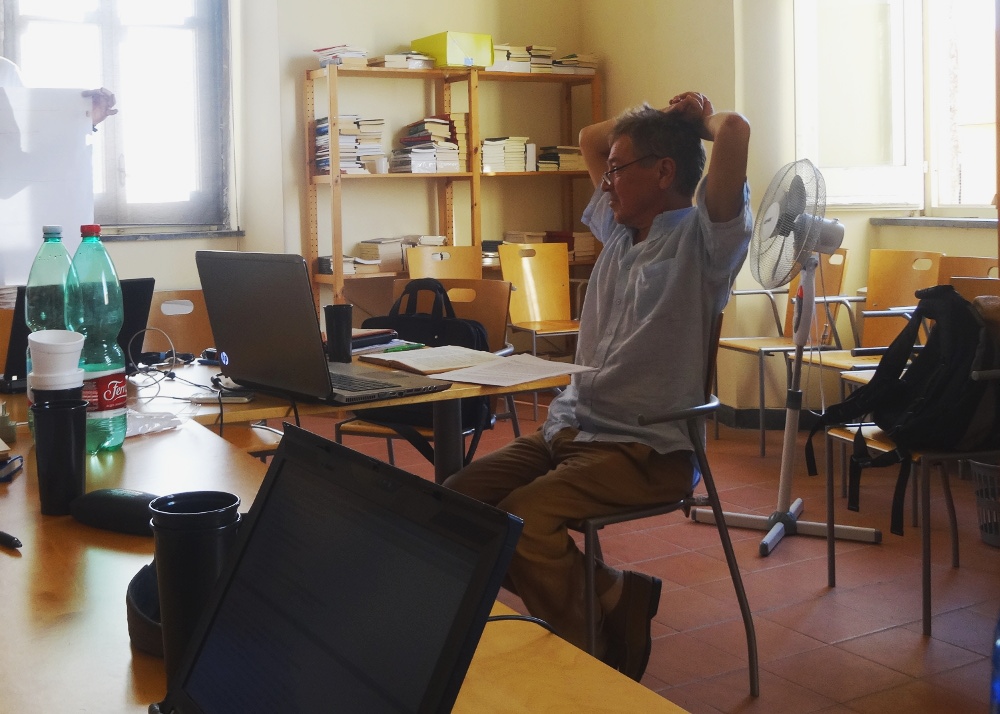Who invented the apoha theory? If you, like me, are prone to answer “Dignāga” and to add that Dignāga (as shown by Hattori) was inspired by Bhartṛhari’s theory and that Dharmakīrti and Dharmottara later fine-tuned Dignāga’s one, you are ready to have your view challenged by K. Kunjunni Raja’s article in Buddhist Logic and Epistemology (ed. by B.K. Matilal and R.D. Evans, 1986, I am grateful to Sudipta Munsi who sent me a copy of it).
Category Archives: Sanskrit Philosophy
Sucarita Miśra on apoha —On Kataoka 2014a
Who is the most productive scholar on Indian Philosophy? Kei Kataoka is surely in the top-10 (have a look at his publications here).
Who studied Mīmāṃsā deontics?
Since Mīmāṃsā (both in its Bhāṭṭa and in its Prābhākara subschools) focused primarily on the exegesis of the prescriptive portion of the Vedic Sacred Texts, the Mīmāṃsā texts offer richly developed discussions of deontic issues, both from a linguistic and from a logic point of view. Unfortunately, the lack of philosophically accessible translations has made most of such discussions remain confined to Sanskritists.
Possible applications of Mīmāṃsā deontics: on Chaudhuri and Vardi
There are fields in which the contribution of applied ethics and deontics are more than needed, such as that of the programming of artificial intelligence connected to robots which might interact with human beings. Chaudhuri and Vardi (their article can be downloaded here) quote the following case:
Helmut Krasser, the Rebel Sanskritist —UPDATED
I met Helmut Krasser during my Erasmus year in Vienna, back in the Nineties. We sat together (meaning that he, Horst Lasic and Ernst Steinkellner prepared and led the meetings whereas I and other people tried to follow and to add minor points from time to time) at the Academy, reading Jinendrabuddhi’s commentary on Dignāga’s Pramāṇasamuccaya.
मीमांसान्याययोः शब्दविषये विवादः -१-
पूर्वमीमांसासूत्रे सू॰ १।१।६ अरभ्य सू॰ १।१।२३ पर्यन्तम् शब्दस्वरूपविषये नैयायिकानां पूर्वपक्षाः प्रदर्शिताः (१।१।६–१।१।११) प्रतिवदिताश्च ।
१।१।६ विषयं प्रतिजानाति “कर्म एके तत्र दर्शनात्” इति । एके − नैयायिकाः मन्यन्ते, शब्दः कर्मैवास्ति, प्रयत्नानन्तरदर्शनाद् इति यावत् ।
१।१।७ सूत्रे द्वितीयो हेतुरुक्तः “अस्थानात्” इति । शब्दः कर्म, यतः शीघ्रं विनश्यति, विनष्टश्च न कुत्रचिदुपलभ्यते । सन्ति तु अर्थाः, ये सन्तोऽपि नोपलभ्यन्ते, मेरुवत् इति चेन्न । मेर्वादयः व्यवधानेभ्य एव नोपलभ्यन्ते । व्यवधानं विना सर्वमुपलभ्यमिति नैयायिकः ।
१।१।८ सूत्रेऽपि हेतुरुच्यते “करोतिशब्दात्” इति । लोके “सः शब्दं करोति” इति यावत् । किमर्थं लोकव्यवहारं प्रमाणमिति चेत्, उच्यते − यथा लोके वदन्ति तथा चिन्तयन्ति, न चानुपलब्धं किंचिद्वर्तते इति सूत्रे १।१।७ उक्तम् । तस्माद् यदुपलब्धं तच्चिन्तितं, यच्चिन्तितं च तल्लोकव्यवहारे व्यक्तमिति लोकव्यवहारः प्रमाणमिति नैयायिकः । तत्र तु −संस्कृता वागपि संकेतिका इति नैयायिकाः । अत एव संभवति यत् केवलं संस्कृतायां भाषायां “शब्दं करोति” इति व्यवहारोऽस्ति । वस्तुतश्च हङ्गरीभाषायां “शब्दं प्रमुञ्चति” इत्युच्यते, न तु “करोति” ।
१।१।९ सूत्रे यौगपद्यं हेतुत्वेनोक्तम् “सत्त्वान्तरे च यौगपद्यात्” इति । नानादेशेषु “शब्द”शब्दादयः यौगपद्येन श्रुताः । यद्येक एव शब्दो भवेत्, तर्हि एतदसम्भवम् । यथाहि ममैकः पुत्रः केवलं पाटलिपुत्रे दृश्यते, न तु यौगपद्येन पाटलिपुत्रे वारणसीपूरे च ।
किम् मन्यन्ते तत्रभवन्तः, कः कः हेतुः युक्ततमः?
शब्दस्वरूप एतत् “पोस्ट्” अपि पठितव्यम्
What is unreal?
The term tuccha means in Classical Sanksrit “worthless”, “insignificant”. In Vedānta, however, it gets a more specific technical meaning, to denote the absolute unreality of chimeral entities, such as the khapuṣpa (flower in the air), which will not and cannot ever exist.
Will the journey ever come to its goal? On Clooney 2013
Several years ago I had some pain in convincing a friend working on Husserl that the “phenomenologist” J. Mohanty which he knew too well was the same as the scholar of Sanskrit Philosophy J.N. Mohanty (I had similar problems in convincing the same person that avatar is a Sanskrit word). Just like there are two Mohantys, with two different target audiences, so there are two F.X. Clooneys.
Kamaleswara Bhattacharya’s death
(the author of the following post is Gianni Pellegrini)
he akhilavidyāmūrte! śubhās te pathānaḥ santu…
It was 2002, a very humid August, perhaps near 12.00 o’clock.
I was attending my class of Nyāyabodhinī, in the glorious Nyāya-Vaiśeṣika department sitting in the old (1791) Mukhyabhavana of the Sampurnanada Sanskrita University (Varanasi). In the middle of the lesson entered a tiny aged figure, with very bright eyes and shining face.
Research Associate in Buddhism, University of Cambridge Faculty of Divinity
Salary: £28,132-£36,661
Reference: 02862
Closing date: 22 April 2014

